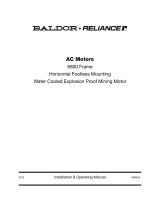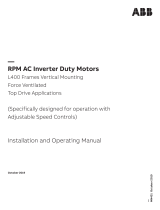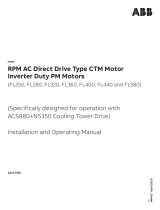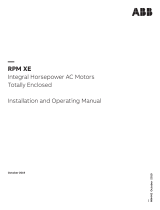Page is loading ...

1
WARNING: Because of the possible danger to person(s) or
property from accidents which may result from the improper use
of products, it is important that correct procedures be followed.
Products must be used in accordance with the engineering
information specified in the catalog. Proper installation,
maintenance and operation procedures must be observed.
The instructions in the instruction manuals must be followed.
Inspections should be made as necessary to assure safe
operation under prevailing conditions. Proper guards and other
suitable safety devices or procedures as may be desirable or as
may be specified in safety codes should be provided, and are
neither provided by ABB nor are the responsibility of ABB. This
unit and its associated equipment must be installed, adjusted
and maintained by qualified personnel who are familiar with the
construction and operation of all equipment in the system and
the potential hazards involved. When risk to persons or property
may be involved, a holding device must be an integral part of the
driven equipment beyond the speed reducer output shaft.
WARNING: To ensure the drive is not unexpectedly started, turn
off and lock-out or tag power source before proceeding. Failure
to observe these precautions could result in bodily injury.
Instruction Manual DODGE
®
DGF Gear Couplings
These instructions must be read thoroughly before installation or operation. This instruction manual was accurate at the time of printing.
Please see baldor.com for updated instruction manuals.
Note! The manufacturer of these products, Baldor Electric Company, became ABB Motors and Mechanical Inc. on
March 1, 2018. Nameplates, Declaration of Conformity and other collateral material may contain the company name of Baldor
Electric Company and the brand names of Baldor-Dodge and Baldor-Reliance until such time as all materials have been
updated to reflect our new corporate identity.
INSTALLATION
Table 1 - "X" Dimension between drive and driven hub ends
Size
Standard One Hub Reversed Two Hubs Reversed
in. mm in. mm in. mm
1 0.13 3.30 0.44 11.18 0.75 19.05
1.5 0.13 3.30 0.38 9.65 0.63 16.00
2 0.13 3.30 0.81 20.57 1.50 38.10
2.5 0.19 4.83 0.97 24.64 1.75 44.45
3 0.19 4.83 0.84 21.34 1.50 3 8.10
3.5 0.25 6.35 0.81 20.57 1.38 35.05
4 0.25 6.35 0.94 23.88 1.63 41.40
4.5 0.31 7.87 1.53 38.86 2.75 69.85
5 0.31 7.87 1.66 42.16 3.00 76.20
5.5 0.31 7.87 1.53 38.86 2.75 69.85
6 0.31 7.87 1.72 43.69 3.13 79.50
7 0.38 9.65 1.69 42.93 3.00 76.20
1. Be sure all components are present and free of burrs or chips.
2. Coat rubber seals with a light lm of grease. Be certain the
rubber seals are properly seated in the anges.
3. Place the sleeves over the shaft ends. Care should be taken not
to damage the rubber seals.
4. Install the hubs on the respective shafts. Interference t hubs
often require heating the hubs in hot oil or an oven to 320ºF
(160°C) prior to installation. The hub faces shall be ush with the
shaft ends.
5. Locate the driver and driven machinery to maintain the “X”
dimension between the driver and driven hub ends, per Table 1,
illustrated in Figure 1
6. Using a dial indicator, check the angular and parallel alignment of
the hubs.
Angular Method – Attach the dial indicator to the base of one
hub and the indicator needle against the face of the other hub.
Rotate the hub on which the indicator base is attached, check
the dial at 90º intervals. All four points should be the same
reading on the dial.
Parallel Method – Attach the dial indicator to the base of one
hub and the indicator needle against the OD of the other hub.
Rotate the hub on which the indicator base is attached, check
the dial at 90º intervals. All four points should be the same
reading on the dial.
Use Figure 5 to determine the maximum TIR for the Face
(angular) and the OD (parallel) based on the operating speed of
the coupling.
Locate the line representing the RPM at which the coupling
will operate. The point at which that line crosses the horizontal
axis indicates the maximum TIR on the face, or the maximum
allowable angular misalignment. The point at which that line
crosses the vertical axis indicates the maximum allowable TIR
on the outside diameter, or the maximum allowable parallel
misalignment.
* Coupling wear is related to misalignment, therefore, to achieve
maximum coupling life, misalignment shall be minimized.
X
STANDARD
ONE HUB REVERSED
BOTH HUBS REVERSED
X
X
X
Figure 1 - “X” Dimension Between the Driver and Driven Hub Ends
WARNING: All products over 25 kg (55 lbs) are noted on the
shipping package. Proper lifting practices are required for these
products.

*4026-0918*
All Rights Reserved. Printed in USA.
09/18 Printshop 2000
© ABB Motors and Mechanical Inc.
MN4026 (Replaces 499696)
—
ABB Motors and Mechanical Inc.
5711 R. S. Boreham Jr. Street
Fort Smith, AR 72901
Ph: 1.479.646.4711
Mechanical Power Transmission Support
Ph: 1.864.297.4800
new.abb.com/mechanical-power-transmission
baldor.com
7. If the coupling is to be grease lubricated, coat all gear tooth
areas with grease. Dodge coupling grease is recommended.
Refer to Table 3 for part numbers.
8. Slide the sleeves over the hubs and install the gasket between
the two sleeves.
9. Install and progressively tighten the bolts with a torque wrench
until the proper torque value , per Table 2, is met.
Table 2 - Torque Values
Size
Bolt Torque Grease Capacity
Min RPM
(Grease)
in.-lbs Nm Oz g
1 130 15 2 57 529
1.5 425 48 3 85 463
2 940 106 5 142 411
2.5 1750 198 9 255 380
3 1750 198 14 397 348
3.5 2650 299 18 510 321
4 2650 299 28 794 301
4.5 2650 299 48 1361 285
5 3650 412 56 1588 268
5.5 3650 412 84 2381 257
6 3650 412 92 2608 240
7 4850 548 134 3799 227
Table 3 - Grease
Description Part Number
Dodge Coupling Grease - 0.96 oz. polybag 012992
Dodge Coupling Grease - 1.44 oz. polybag 012993
Dodge Coupling Grease - 1.92 oz. polybag 012994
Dodge Coupling Grease - 14 oz. cartridge 012995
Dodge Coupling Grease - 10-pack of 14 oz. cartridges 012996
Dodge Coupling Grease - Case (Qty. 30 - 14 oz. cartridges) 012997
Dodge Coupling Grease - 35 lb. pail 012927
Dodge Coupling Grease - 120 lb. keg 012928
Dodge Coupling Grease - 400 lb. drum 012929
Remove lubrication plugs in each sleeve, add grease specied until
lled.
NOTE: If RPM is below minimum, use SAE 90 oil in lieu of
grease.
When using oil, it is recommended to seal the gaps in key/
keyway with a sealant.
10. Install proper coupling guards per OSHA, or applicable
requirements.
Maintenance
1. It is recommended that the coupling be completely ushed and
relubricated after an initial break-in period of 3 million revolutions.
(80 Hrs. @ 600 RPM).
2. Under normal industrial conditions the coupling should be
disassembled, cleaned, and inspected every year. More
severe applications may require more frequent inspection and
relubrication.
3. During any inspection of the coupling when gear tooth wear is
evident or the seal is leaking, it is recommended to replace the
worn parts.
4. Upon reassembly after inspection always refer to the installation
section for proper installation and bolt torque. Always regrease
the coupling after inspection. Grease, which complies with
AGMA9001-B97, or any NLGI grade 0–00, lithium-based grease
with EP additives, is recommended.
5. Successful operation is dependent upon adequate lubrication.
Precaution should be taken during handling and recycling
grease, oil or water glycol mixtures.
Additional Instruction for Safe Installation and Use
All rotating parts should be guarded to prevent contact with foreign
objects which could result in sparks, ignition, or damage to the
coupling.
1. Couplings should be periodically inspected for normal wear, dust/
dirt buildup or any similar scenario that would impeded heat
dissipation.
2. Increasing levels of vibration and noise could indicate the need for
inspection, repair or replacement of the coupling.
3. Electrical sparks are a source of ignition. To reduce the risk, proper
electrical bonding and grounding is recommended.
4. Overloading may result in breakage or damage to the coupling
or other equipment. As a result the coupling could become an
explosion hazard. Damaged coupling components or elements
must not be operated in hazardous environment.
Max. OD Runout (in.)
Max. Face Runout (in.)
0.001
0.002
0.003 0.004
0.006
0.008
0.01
0.001
0.002
0.003
0.004
0.005
0.006
0.007
0.008
0.01
0.020
1000
2000
3000
4000
5000
6000
7000
8000
9500
12000
15000
Figure 2 - Face and OD TIR
/






